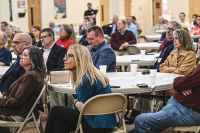The Naturalist's Corner
A note of interest
The US Fish & Wildlife Service has extended the public comment period on its John H. Chafee Coastal Barrier Resources System Digital Mapping Pilot Project through Aug. 5, 2009, and has included opportunities for public participation through virtual town meetings on July 14 and 15.
The Coastal Barriers Resources Act (CBRA) was enacted by Congress in 1982 with the intent of protecting coastal barriers by denying federal incentives like federal flood insurance and most federal infrastructure expenditures that promote development. To date the Coastal Barrier Resources System applies to approximately 3 million acres of coastal barriers along the Gulf of Mexico, Great Lakes and Atlantic coast. It includes 2,500 miles of shoreline and 585 CBRA units plus 271 OPAs.
An OPA is an Otherwise Protected Area, which CBRA defines as, “... an undeveloped coastal barrier within the boundaries of an area established under Federal, State, or local law, or held by a qualified organization, primarily for wildlife refuge, sanctuary, recreational, or natural resource conservation purposes.” The only federal funding prohibited in an OPA is flood insurance.
CBRA was renewed in 2000 and at that time the US Fish & Wildlife Service was assigned the task of establishing a procedure and determining the costs for updating maps from outdated hard copies to state of the art digital ones.
The 2005 CBRA renewal called for called for the mapping pilot project and public review. Fish & Wildlife mapped approximately 10 percent (70 units) of the Coastal Barriers Resources System with new digital technology. The report recommends remapping the entire CBRS using the new digital technology because the existing maps are outdated and inaccurate. The estimated cost to complete the re-mapping is $17 million.
Related Items
Ten areas in the Carolinas were digitally re-mapped. They are Pine Island, Roosevelt Natural Area, Hammocks Beach in Onslow County, Hammocks Beach in Carteret County, Onslow Beach Complex, Topsail, Lea Island Complex, Wrightsville Beach and Masonboro Island in North Carolina and Litchfield Beach and Pawleys Inlet in South Carolina.
The Gulf Coast and the Outer Banks may be out of sight but for most of us they are never out of mind. The more than 180 million Americans who visit coastal states like North Carolina every year generate more than $560 billion in tourism revenue.
These barrier resources like tidal channels, marshes and shallow lakes are invaluable marine nurseries helping support the $116 billion per year sport and commercial fishing industries. Plus they are home to rare and endangered species like piping plover, sea turtles and manatees.
The marshes of coastal barriers also act as sponges, soaking up storm surges from hurricanes and other coastal storms. According to scientists every 2.7 miles of barrier wetlands can absorb one foot of storm surge. A 1970s-era Louisiana coastline could have absorbed as much as seven feet of Katrina’s (2005) 20-foot storm surge, perhaps saving New Orleans from flooding.
Information and maps for downloading are available at www.fws.gov/habitatconservation/coastal_barrier.html.
The closest place I found to get your hands on hard copies is US Fish & Wildlife offices at 1875 Century Boulevard, Suite 400, Atlanta, Ga. The phone number in Atlanta is 404.679.4000.
Other inquiries can be made to Katie Niemi, Coastal Barrier Coordinator at 703.358.2161.
You may comment by mail to Coastal Barriers Coordinator, Division of Habitat and Resource Conservation, U.S. Fish and Wildlife Service, 4401 North Fairfax Drive, Room 860A, Arlington, VA 22203 or electronically to This email address is being protected from spambots. You need JavaScript enabled to view it..
You must register by July 10 to participate in the virtual public meetings. The meeting for the Carolinas is scheduled for July 14 from 1 p.m. to 3 p.m. eastern time. Register at www.fws.gov/habitatconservation/coastal_barrier.html.









